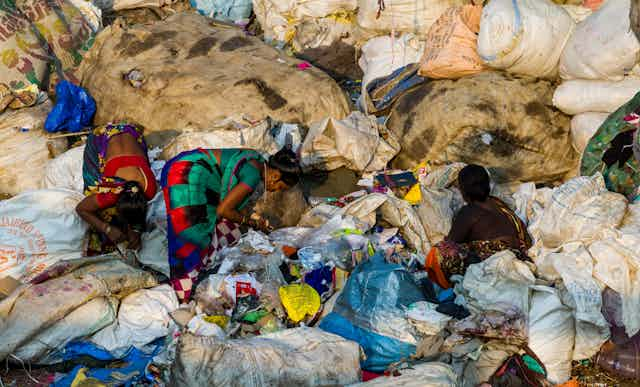Taboos around menstruation and notions of dirt and shame are leading India’s consumers and waste pickers to contribute to a growing environmental crisis. The country is already struggling to efficiently manage all kinds of waste.
My new research has revealed that if the disposability of menstrual products is not prioritised as much as their accessibility, the country could be dealing with mountains of discarded waste products in less than 50 years.
Menstrual products (which include tampons and synthetic pads) are often championed by manufacturers, NGOs and governments as the only alternative for women to manage their menstruation with dignity. But the resulting waste from discarded products is a growing issue that has significant environmental consequences. This is a particularly pressing problem in countries like India that lack waste disposal infrastructure.

It is difficult to find reliable estimates on the exact quantity of menstrual waste, particularly in developing countries. This limits our understanding of the environmental impacts from these products. So for my research, I drew on market data and population growth estimates to conduct an analysis of the potential growth of menstrual waste in India.
My estimates show that by 2070, when sales are expected to reach a saturation point of 100bn units, India could be dealing with 800,000 tons of menstrual waste per year. Today, this waste amounts to over 100,000 tons. But there is a significant number of women who are yet to gain access to menstrual products.
Read more: The future of periods can now be sustainable and cheap
This was underlined in the latest national survey which found that only 48% of rural women and 78% of urban women used a “hygienic method of menstrual protection”. But this survey only considered women aged between 15 and 24. It is also important to note that not all people who menstruate identify as women. I only considered female consumers in my study, which shows that real numbers could be even larger.
To make matters worse, these estimates are only for waste from discarded, disposable pads. I found that women follow a wide range of other practices to dispose of these products – such as burning them, washing them (even those which are disposable) and wrapping them in plastic bags before throwing them away on the streets or into communal toilets. These practices are informed by notions of shame and dirt, which can be attributed to cultural and religious beliefs around menstruation.
Existing environmental impact assessments of menstrual products often fail to take into account local disposal practices like these. If sales in India reach 30bn menstrual products by 2030 (as expected by market growth projections), and if all these products are washed and wrapped, this would result in 1,800m tons of plastic and wastewater per year. These environmental impacts would be on top of those resulting from the disposal of the actual menstrual products themselves.
The role of waste pickers
There is another, more human, aspect to India’s waste problem. My findings show that waste pickers may actually be contributing to the environmental issues because of the practices they follow, which are often informed by notions of shame and dirt.
Both female and male waste pickers believe that menstrual blood is a source of harm to those who are exposed to it. In addition, they share the view that menstrual waste is “female waste” and should only be handled by women. In the words of one male waste picker I interviewed:
Males feel disgusted if they get to see this. Ladies don’t feel so bad about it.
These perceptions stop many waste pickers from collecting and segregating menstrual products. Instead they tend to throw menstrual waste in open areas like construction sites or they burn it. This increases the likelihood that this waste will not be adequately destroyed. In the words of one female waste picker: “If we throw [this waste] in [a] place where no person is living, there will be no pollution.”
In addition, the negative perceptions around this type of work and caste can compound the challenges that waste pickers face when it comes to managing this specific refuse. In India, approximately 95% of waste pickers are from the lower caste in the Hindu system.
These social norms can make waste pickers feel unable to request that consumers segregate menstrual waste. They also result in consumers being reluctant to respond to their demands. Another waste collector told me how they were expected to take away whatever their customers gave them, no questions asked. She added:
If I would tell them [to segregate this waste] then they would say you [are] stupid, you pick the trash and you take the money.
What now?
My research indicates that some simple steps could make a big difference. Here are some of the recommendations I’ve set out for policymakers:
Integrate information on disposal across all menstrual hygiene management programmes, including adequate management in different settings (including schools, homes and public spaces).
Collect data on the use of menstrual products to estimate the volume of waste and design appropriate processes to manage it.
Invest in the development of waste management systems that reduce the quantities of menstrual waste that go into landfills, such as waste-to-energy incinerators.
Collaborate with NGOs to train waste pickers on the management of menstrual waste.
The taboos around menstruation need to be addressed to drive change in disposal and waste management practices and prevent the already dire environmental situation from getting much worse.
While a number of countries, including India, are putting policies in place to improve menstrual hygiene management, how these products are actually being disposed of has been largely overlooked. That needs to change now.

